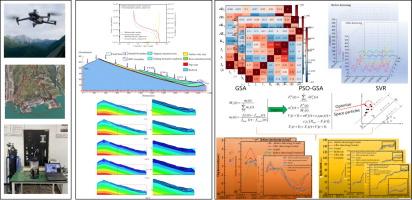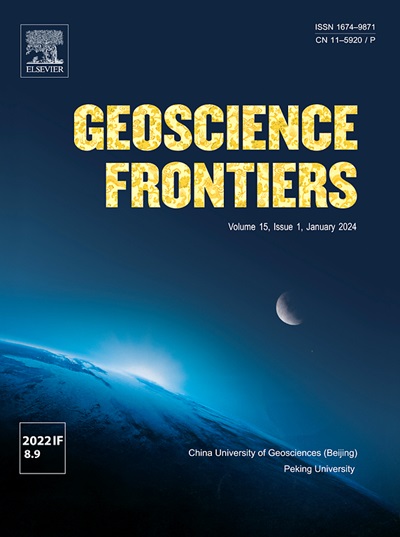Analyzing failure mechanisms and predicting step-like displacement: Rainfall and RWL dynamics in lock-unlock landslides
IF 8.5
1区 地球科学
Q1 GEOSCIENCES, MULTIDISCIPLINARY
引用次数: 0
Abstract
Lock-unlock landslides have thick sliding zones that store a lot of energy. This makes them start quickly, happen suddenly, and have serious consequences. Therefore, it becomes urgent to study the deformation and failure mechanisms of such landslides and develop rational predictive models. Taking the Jiuxianping landslide as an example, this study investigates the regularity of landslide displacement changes using multi-source data, focusing on the abrupt displacement patterns in the unlock phase. Furthermore, employing Transient Release and Inhalation Method tests combined with Geo-Studio’s SEEP/W and SIGMA/W modules for fluid–solid coupled simulation calculations, the evolution process of landslide failure mechanisms and deformation characteristics is analyzed and discussed. Lastly, utilizing data mining analysis of multi-source data, a hybrid optimized machine learning predictive model is established for model prediction comparison. The study reveals that: (1) The rise in infiltration line elevates pore water pressure, affecting the stability of the sliding zone, leading to “unlock effects” and step-like displacement deformation; (2) Simulation shows that YY208 is closer to the actual situation, located at the far bank position, while YY210 is greatly influenced by the “buoyancy effect”, resulting in a slowdown in deformation velocity; (3) After data preprocessing, overall actual displacement prediction performs better than simulation displacement prediction in terms of Mean Absolute Error, Mean Squared Error and Correlation Coefficient, but noise reduction processing can improve the periodic prediction effect of simulation displacement.

分析破坏机制并预测阶梯状位移:锁定-解锁滑坡中的降雨和 RWL 动力学
锁定-解锁型山体滑坡有很厚的滑动带,可以储存大量能量。这使得它们启动迅速,发生突然,后果严重。因此,研究这类滑坡的变形和破坏机理,并建立合理的预测模型已迫在眉睫。本研究以酒仙坪滑坡为例,利用多源数据研究了滑坡位移变化的规律性,重点研究了解锁阶段的突变位移模式。此外,结合 Geo-Studio 的 SEEP/W 和 SIGMA/W 模块进行流固耦合模拟计算,采用瞬态释放和吸入法试验,分析和讨论了滑坡崩塌机理和变形特征的演化过程。最后,利用多源数据的数据挖掘分析,建立了一个混合优化的机器学习预测模型,用于模型预测比较。研究结果表明(1) 渗透线的上升使孔隙水压力升高,影响滑动带的稳定性,导致 "解锁效应 "和阶梯状位移变形;(2) 模拟结果表明,YY208 位于远岸位置,更接近实际情况,而 YY210 受 "浮力效应 "影响较大,导致变形速度减慢;(3) 经过数据预处理后,实际位移预测在平均绝对误差、平均平方误差和相关系数方面均优于模拟位移预测,但降噪处理可改善模拟位移的周期预测效果。
本文章由计算机程序翻译,如有差异,请以英文原文为准。
求助全文
约1分钟内获得全文
求助全文
来源期刊

Geoscience frontiers
Earth and Planetary Sciences-General Earth and Planetary Sciences
CiteScore
17.80
自引率
3.40%
发文量
147
审稿时长
35 days
期刊介绍:
Geoscience Frontiers (GSF) is the Journal of China University of Geosciences (Beijing) and Peking University. It publishes peer-reviewed research articles and reviews in interdisciplinary fields of Earth and Planetary Sciences. GSF covers various research areas including petrology and geochemistry, lithospheric architecture and mantle dynamics, global tectonics, economic geology and fuel exploration, geophysics, stratigraphy and paleontology, environmental and engineering geology, astrogeology, and the nexus of resources-energy-emissions-climate under Sustainable Development Goals. The journal aims to bridge innovative, provocative, and challenging concepts and models in these fields, providing insights on correlations and evolution.
 求助内容:
求助内容: 应助结果提醒方式:
应助结果提醒方式:


